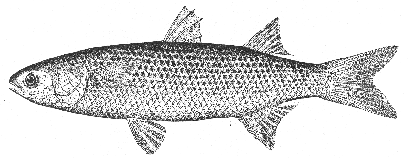Mullet Mugil cephalus Linnaeus 1758
COMMON MULLET; STRIPED MULLET; JUMPING MULLET
[Jordan and Evermann, 1896-1900, p. 811.]
Description—
The common mullet, the only one of its numerous tribe (there are more than 100 species of mullets) that has been known to stray north of Cape Cod, has a spiny first dorsal and soft second dorsal fin, the two well separated as in the silverside, and its ventrals are located on the abdomen. It is a much larger fish than the silverside, however, and even very young mullets of the [page 306] size of the latter (4 to 5 inches long) are easily separable from silversides by the fact that their anal fin is only about half as long in relation to the length of the body, while the second dorsal originates over the origin of the anal instead of well behind it. Furthermore, the head of the mullet is shorter; its nose blunter; its profile quite different (compare fig. 164 with fig. 159); its eye smaller; its body stouter (about one-fourth as deep as long); and it lacks the silvery side stripes so characteristic of the common silverside. There are four spines in its first dorsal fin, 1 spine and 8 soft rays in the second dorsal, 3 spines and (usually) 8 rays in the anal. Young fish, 2 inches long or less, have only 2 spines in the anal, the first soft ray later developing into a spine.[57] The first dorsal stands over the tips of the pectorals or close behind them; and the tail is forked moderately deep. The soft dorsal fin and anal fin are almost naked (they are scaled in most of the other American mullets), but the body and head are clothed with large rounded scales.
Color—
Adults are bluish gray or greenish above, silvery on the lower part of the sides and below; the scales on the sides have dark centers which form longitudinal lines; the fins are sometimes partly dusky. Young fry are bright silvery.
Size—
The common mullet grows to a length of 2½ feet in warmer waters, but small specimens alone have been found along our northern coasts.
General range—
Both sides of the temperate Atlantic; from Brazil to Cape Cod on the American coast, and as a stray to outer Nova Scotia; also along the west coast of America from Monterey (Calif.) to Chile, and in other parts of the Pacific.
Occurrence in the Gulf of Maine—
Mullets are common as far north as New York, less so to Woods Hole, but so rarely do they stray past Cape Cod that there are only a half dozen records of them in the Gulf of Maine, viz, at Provincetown, at Essex[58] in northern Massachusetts, at Freeport, Harraseeket River, Clapboard Island, and Casco Bay in Maine, each based on an odd fish. And one has also been taken in Bedford Basin near Halifax, Nova Scotia.[59] Mullet are more likely to visit the cool waters of the Gulf in late summer or early autumn than at any other season. They have been known to winter as far north as New York, in the mud, but it is not likely that the few strays that round Cape Cod survive the cold season, nor is there any reason to suppose they ever breed in the Gulf, for immature fish alone are found at Woods Hole.
[57] See Jacot (Trans. Amer. Microscopical Soc., vol. 39, 1920, pp. 204-214) for a study of the growth of the mullet.
[58] There is (or was) a specimen so labeled in the collection of the Boston Society of Natural History.
[59] Reported by Vladykov, Proc. Nova Scotian Inst. Sci., vol. 19, 1935, p. 6.
